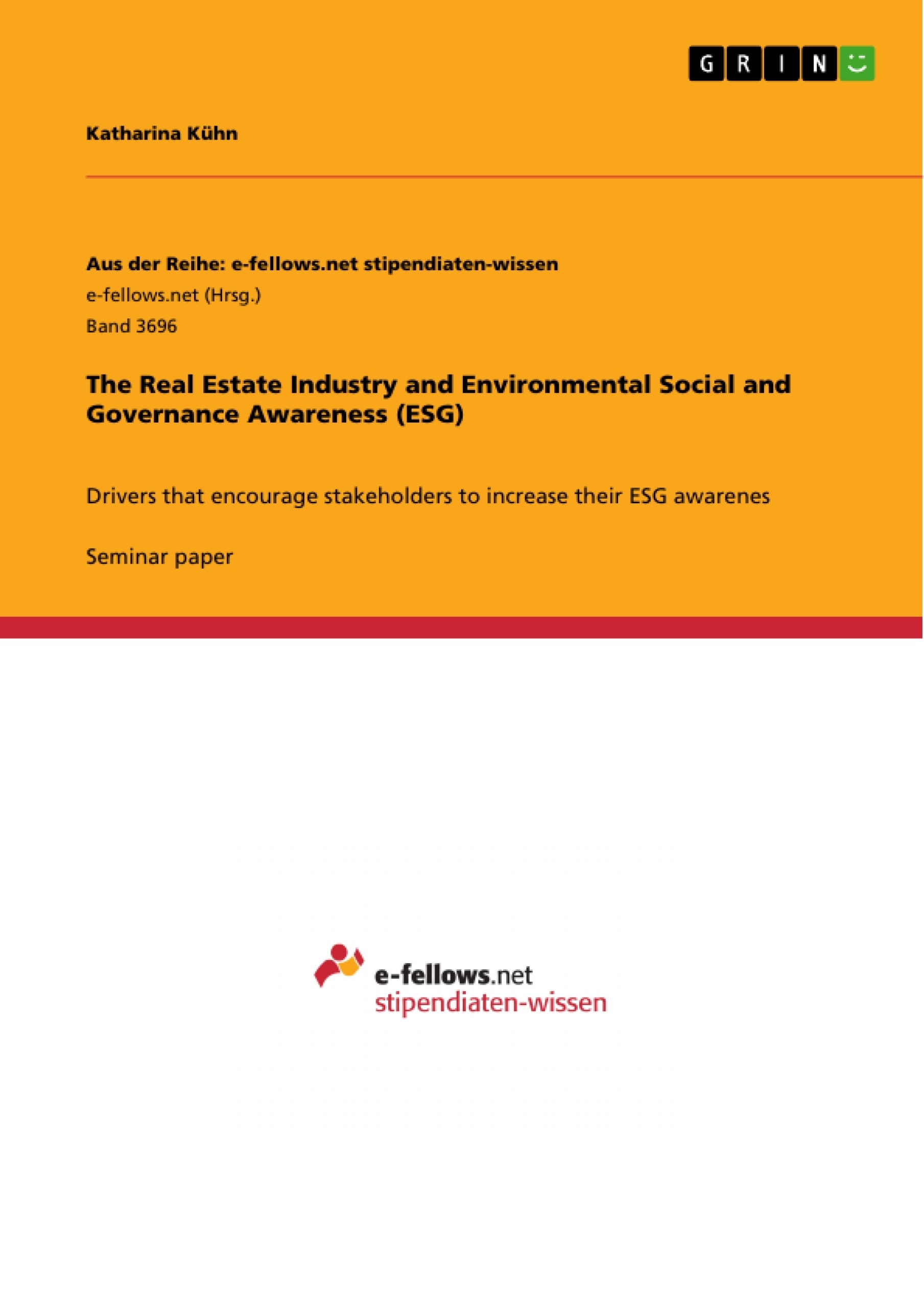The objective of this paper is to identify potential metrics that can be used to measure the awareness of environmental, social, and governance factors within the real estate industry effectively. Thereby, this paper also attempts to identify drivers that encourage stakeholders to increase their ESG awareness.
This paper further looks at the issue of ESG for the real estate industry from a macro perspective rather than a micro-perspective. Thus, metrics will be accordingly high-level to hopefully capture the awareness within the market from a multi-dimensional perspective, rather than analyzing the ESG metrics for a single player in the real estate industry.
As one of the industries with the highest carbon footprint, the real estate sector needs to cut 77 % of total carbon emissions by 2050 compared to 2016 in order to meet goals set out in the UN Paris Agreement. These facts are alarming. Especially the longevity of real estate makes ESG issues particularly relevant for this industry. Thus, the real estate industry carries a significant amount of importance and responsibility when it comes to reaching these climate goals.
Inhaltsverzeichnis (Table of Contents)
- Introduction
- The Real Estate Industry and ESG
- The Real Estate Market
- Definition
- Industry Dynamics
- Real Estate Industry Audiences
- E, S, and G
- Environmental Issues
- Social Issues
- Governance Issues
- The Real Estate Market
- Stakeholders and Metrics for Their ESG Awareness
- ESG Awareness of External Stakeholders
- Society's Interest and Influence
- Metrics for ESG Awareness Among Society
- Government's Interest and Influence
- Metrics for ESG Awareness of Governments
- ESG Relevance and Metrics for Direct Stakeholders
- Intrinsic Motivations for Real Estate Companies to Engage in ESG
- Metrics to Measure ESG Awareness of Players in the Real Estate Industry
- Critical Appraisal
- ESG Awareness of External Stakeholders
- Case Studies for Market Metrics
- Measuring ESG Awareness in Brazil
- The Case of Sao Paulo, Brazil
- Discussion
- Measuring ESG Awareness in Malaysia
- The Case of Malaysia
- Discussion
- Measuring ESG Awareness in Canada
- The Case of Canada
- Discussion
- Measuring ESG Awareness in Brazil
- Measuring ESG Awareness Effectively
- Market Metric Insights
- Driver Metric Insights
- General Insights for Developed vs. Developing Markets
- Critical Appraisal
Zielsetzung und Themenschwerpunkte (Objectives and Key Themes)
This research aims to define and analyze effective metrics for measuring ESG awareness within the real estate industry. The study investigates the key drivers and challenges associated with incorporating ESG principles in real estate practices, considering both internal and external stakeholders. It examines various case studies to identify valuable insights and develop a comprehensive framework for measuring ESG awareness in different market contexts.
- Defining and measuring ESG awareness in the real estate industry
- Analyzing the role and influence of key stakeholders, including investors, tenants, and governments
- Identifying relevant metrics for evaluating ESG performance across various aspects of real estate operations
- Examining case studies to illustrate different approaches to ESG measurement in diverse market contexts
- Developing a framework for effective ESG measurement tailored to the real estate sector
Zusammenfassung der Kapitel (Chapter Summaries)
The introduction provides the problem formulation and objective of the research, emphasizing the need for effective metrics to gauge ESG awareness within the real estate industry. Chapter 2 delves into the real estate market, defining its key features and dynamics, and then elaborates on the concepts of environmental, social, and governance (ESG) issues.
Chapter 3 explores the relevance and metrics for measuring ESG awareness among both external and internal stakeholders. It discusses the influence of society and government on ESG practices and examines the motivations and metrics for real estate companies to engage in ESG initiatives. Chapter 4 presents case studies from Brazil, Malaysia, and Canada, analyzing the specific metrics and drivers used in these markets to measure ESG awareness.
Chapter 5 summarizes the insights gained from the market and driver metrics, offering general insights for developed and developing markets. The chapter also critically assesses the effectiveness of various metrics for measuring ESG awareness. This section concludes by providing a comprehensive list of effective metrics for measuring ESG awareness in the real estate industry.
Schlüsselwörter (Keywords)
The key concepts and terms explored in this work include ESG awareness, real estate industry, stakeholders, metrics, environmental issues, social issues, governance issues, case studies, Brazil, Malaysia, Canada, market dynamics, and driver metrics. The research focuses on developing a framework for measuring ESG awareness in real estate, emphasizing the importance of stakeholder engagement, data collection, and analysis for promoting sustainable practices in the industry.
- Quote paper
- Katharina Kühn (Author), 2020, The Real Estate Industry and Environmental Social and Governance Awareness (ESG), Munich, GRIN Verlag, https://www.hausarbeiten.de/document/974139


